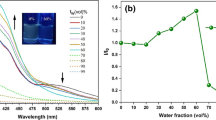Abstract
Nitrate explosive is hard to detect due to lack of aromatic ring and weak interaction with fluorescence probe. More challenging is even to differentiate the dinitrates with multiple nitrate explosives based on photo induced electron transfer or aggregation caused fluorescence change mechanism. A highly selective dinitrate explosive probe was designed based on a new strategy—stepwise aggregation of multiple anchored fluorene dimer 8Py-2F. Compared with its monomer counterpart 2Py-F, 8Py-2F showed a selective and stepwise fluorescence quenching to dinitrate explosives—ethylene glycol (EGDN) and triethylene glycol dinitrate (TEGDN). The limits of detection (LODs) are 2.72 µM for TEGDN and 0.46 µM for EGDN, which is three orders of magnitude lower than those of 2Py-F. The stepwise quenching process is well matched with the stepwise aggregation process as evidence by scanning electron microscopy (SEM). Nuclear magnetic resonance (NMR) and quantum chemical calculation proved the interaction force between the dinitrate and 8Py-2F is hydron bonding interaction, and interaction distance is far less than that of the multiple nitrates coming from the flexibility of the chain and steric hinderance, which resulted in a self-adaptive interaction and higher selectivity. The new strategy is beneficial for the differentiation of the chemicals with similar energy level which is difficult to realize via other method, and the new method provides fluorometric probe for dinitrate explosive detection and makes it an ideal candidate for chemical detection and analysis in public safety and environmental monitoring.
Similar content being viewed by others
References
McQuade DT, Pullen AE, Swager TM. Chem Rev, 2000, 100: 2537–2574
Zhu C, Liu L, Yang Q, Lv F, Wang S. Chem Rev, 2012, 112: 4687–4735
Roy R, Hohng S, Ha T. Nat Methods, 2008, 5: 507–516
Medintz IL, Clapp AR, Mattoussi H, Goldman ER, Fisher B, Mauro JM. Nat Mater, 2003, 2: 630–638
Wang S, Gaylord BS, Bazan GC. J Am Chem Soc, 2004, 126: 5446–5451
Mei J, Leung NLC, Kwok RTK, Lam JWY, Tang BZ. Chem Rev, 2015, 115: 11718–11940
Wang M, Zhang D, Zhang G, Tang Y, Wang S, Zhu D. Anal Chem, 2008, 80: 6443–6448
Dong L, Miao Q, Hai Z, Yuan Y, Liang G. Anal Chem, 2015, 87: 6475–6478
Xia C, Hai X, Chen XW, Wang JH. Talanta, 2017, 168: 269–278
Thomas SW, Joly GD, Swager TM. Chem Rev, 2007, 107: 1339–1386
Swager TM. Acc Chem Res, 1998, 31: 201–207
Ding D, Li K, Liu B, Tang BZ. Acc Chem Res, 2013, 46: 2441–2453
Hong Y, Lam JWY, Tang BZ. Chem Soc Rev, 2011, 40: 5361–5388
Hong Y, Lam JWY, Tang BZ. Chem Commun, 2009, 1: 4332–4353
Sun X, Wang Y, Lei Y. Chem Soc Rev, 2015, 44: 8019–8061
Zhou H, Chua MH, Tang BZ, Xu J. Polym Chem, 2019, 10: 3822–3840
Hu R, Kang Y, Tang BZ. Polym J, 2016, 48: 359–370
Shu W, Guan C, Guo W, Wang C, Shen Y. J Mater Chem, 2012, 22: 3075
Zhou C, Xu W, Zhang P, Jiang M, Chen Y, Kwok RTK, Lee MMS, Shan G, Qi R, Zhou X, Lam JWY, Wang S, Tang BZ. Adv Funct Mater, 2019, 29: 1805986
Roy B, Noguchi T, Yoshihara D, Tsuchiya Y, Dawn A, Shinkai S. Org Biomol Chem, 2014, 12: 561–565
Rouhi AM. Chem Eng News, 1997, 75: 14–22
Wang Y, La A, Ding Y, Liu Y, Lei Y. Adv Funct Mater, 2012, 22: 3547–3555
Salinas Y, Martínez-Máñez R, Marcos MD, Sancenón F, Costero AM, Parra M, Gil S. Chem Soc Rev, 2012, 41: 1261–1296
Chen L, Gao Y, Wang Y, He C, Zhu D, He Q, Cao H, Cheng J. ACS Appl Mater Interfaces, 2014, 6: 8817–8823
Liu A, Liu H, Peng X, Jia J, Fu Y, He Q, Cao H, Cheng J. Anal Methods, 2018, 10: 2567–2574
Ewing R. Talanta, 2001, 54: 515–529
Moore DS. Rev Sci Instrum, 2004, 75: 2499–2512
Walsh M. Talanta, 2001, 54: 427–438
Schulte-Ladbeck R, Kolla P, Karst U. Anal Chem, 2003, 75: 731–735
Batlle R, Carlsson H, Holmgren E, Colmsjö A, Crescenzi C. J Chromatogr A, 2002, 963: 73–82
Laramée JA, Kocher CA, Deinzer ML. Anal Chem, 2002, 64: 2316–2322
Rosengren LG. Appl Opt, 1975, 14: 1960–1976
Li JS, Yu B, Fischer H, Chen W, Yalin AP. Rev Sci Instrum, 2015, 86: 031501
Dunayevskiy I, Tsekoun A, Prasanna M, Go R, Patel CKN. Appl Opt, 2007, 46: 6397–6404
Mukherjee A, Prasanna M, Lane M, Go R, Dunayevskiy I, Tsekoun A, Patel CKN. Appl Opt, 2008, 47: 4884–4887
Mukherjee A, Dunayevskiy I, Prasanna M, Go R, Tsekoun A, Wang X, Fan J, Patel CKN. Appl Opt, 2008, 47: 1543–1548
Kumar C, Patel N. High power infrared QCLs: advances and applications. In: Proceedings of Quantum Sensing and Nanophotonic Devices IX. Volume 8268. San Francisco, 2012
He C, He Q, Chen Q, Shi L, Cao H, Cheng J, Deng C, Lin T. Tetrahedron Lett, 2010, 51: 1317–1321
Straessler NA, Paraskos AJ, Kramer MP. Methods ofproducing nitrate esters. USA Patent, US8658818. 2014
Xu W, Fu Y, Gao Y, Yao J, Fan T, Zhu D, He Q, Cao H, Cheng J. Chem Commun, 2015, 51: 10868–10870
Acknowledgements
This work was supported by the research program from the Ministry of Science and Technology (2017YFC0821100), the National Natural Science Foundation of China (61731016, 61771460), and a grant from the Youth Innovation Promotion Association CAS (2015190).
Author information
Authors and Affiliations
Corresponding authors
Ethics declarations
Conflict of interest The authors declare that they have no conflict of interest.
Supporting Information
11426_2019_9593_MOESM1_ESM.pdf
A Selective and stepwise aggregation of a new fluorescent probe for dinitrate explosive differentiation by self-adaptive host-guest inter-action
Rights and permissions
About this article
Cite this article
Jia, J., Xu, W., Yu, Y. et al. A selective and stepwise aggregation of a new fluorescent probe for dinitrate explosive differentiation by self-adaptive host-guest interaction. Sci. China Chem. 63, 116–125 (2020). https://doi.org/10.1007/s11426-019-9593-4
Received:
Accepted:
Published:
Issue Date:
DOI: https://doi.org/10.1007/s11426-019-9593-4




